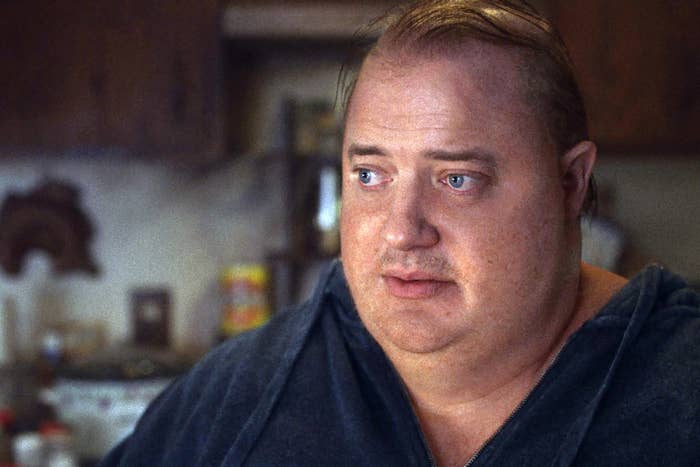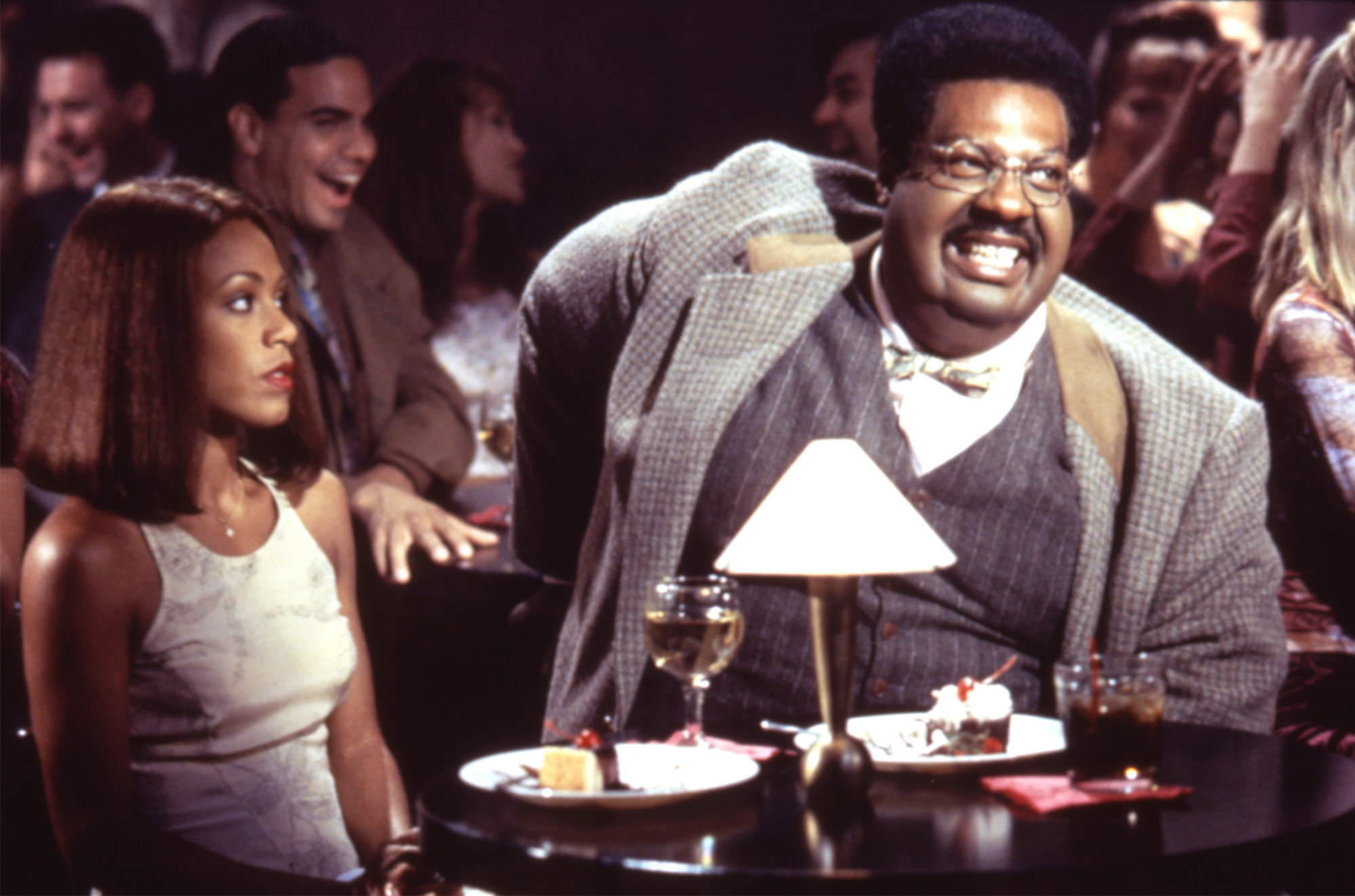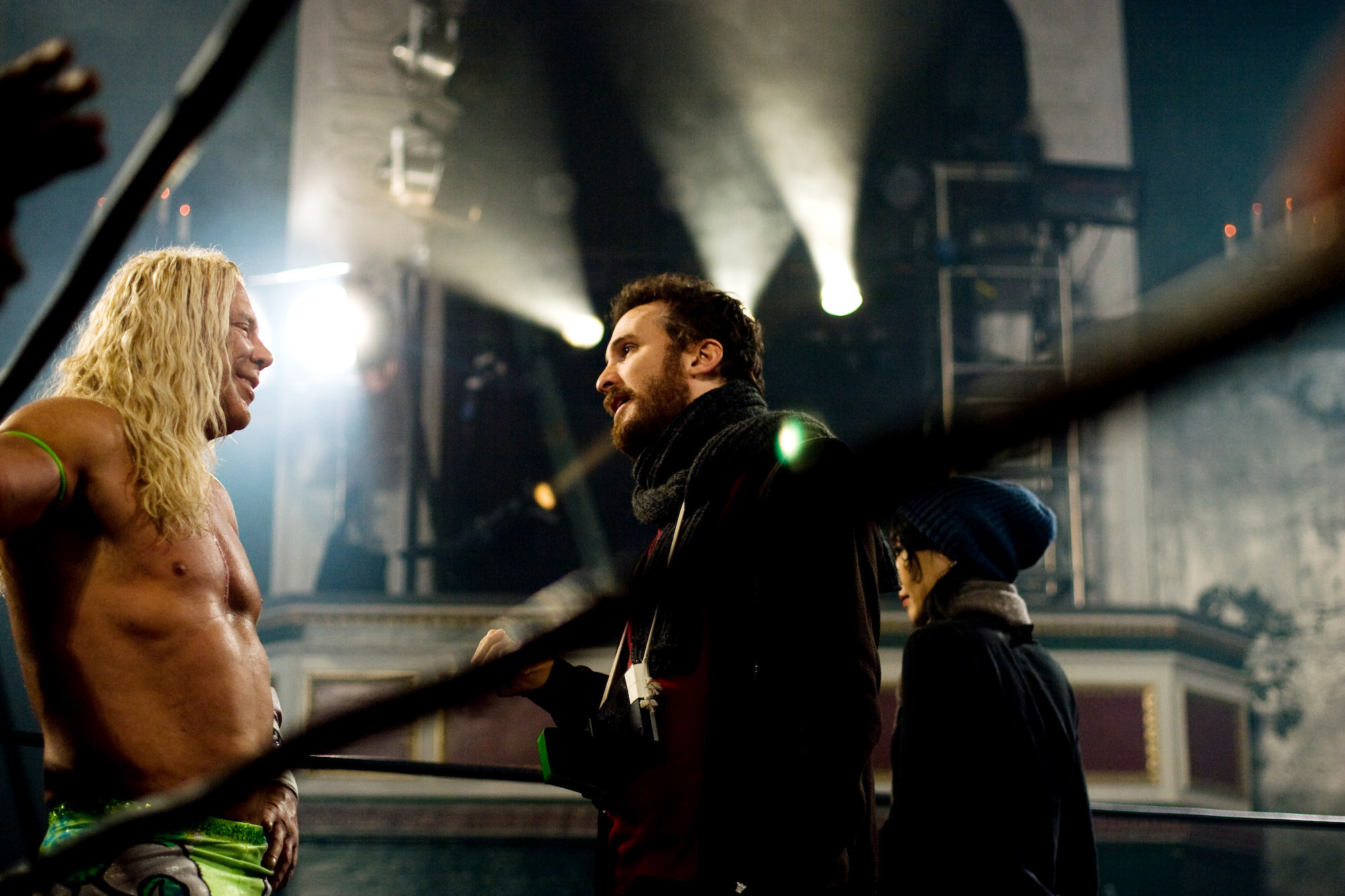
A long time ago, I learned to be skeptical when critics describe a movie as “unflinching.” “Unflinching” is code for “brave,” shorthand for “willing to go there.” But too often, a movie lauded for being unflinching is often a film rather comfortable with the gratuitous. Lee Daniels’s Precious was dubbed an unflinching look at poverty; Crash was called the same but about racism. Neither label has stood the test of time, partially because we have not yet answered some important questions: When does close observation cross the line from empathy into voyeurism? When does careful attention transform into shameless gawking? Depending on how you answer those questions, Darren Aronofsky’s The Whale might either be a masterful display of compassion or an exercise in the familiar denigration of leering at the lives of fat people.
The Whale stars Brendan Fraser as Charlie, a depressed fat man who lives alone somewhere in Idaho. A committed shut-in, Charlie teaches online writing classes with his camera perpetually off while living in a cluttered apartment. We learn that his life radically changed after his partner died by suicide, and he’s been on the road to ruin ever since. Because of his 600-pound frame, Charlie is restricted in his movement — he uses a walker to get around and a handle attached to the ceiling to pull himself onto his bed; he needs a grabber to pick up the things that fall on the floor. The Whale relishes in the minute details of Charlie’s movements, offering close-ups as a kind of substitute for humanity. The camera stays uncomfortably close, or perhaps as a viewer you’re uncomfortable because of how close the camera is. Put one point in the “gratuitousness” column.
The Whale is a movie that doesn’t know when it should have flinched.
When Charlie is not working, he entertains a range of visitors, from his nurse best friend Liz (an outstanding Hong Chau) to his estranged daughter Ellie (Sadie Sink) to Thomas (Ty Simpkins), a young missionary from New Life, a church with a persistent local recruiting effort. But when Charlie learns that his health is failing rapidly and he doesn’t have long to live, these visits take on increasing urgency, and we see how his boundless and occasionally misplaced faith in people transforms the lives of those around him. A reluctant point for Team Compassion, I suppose.
With three months to go until the 2023 Oscars, Fraser is comfortably in the pole position to take home the Best Actor trophy. Before you even factor in his specific performance, this makes some sense: It’s the kind of role that Academy voters love, requiring a profound transformation. There are already elaborate descriptions of the hours-long daily process that Fraser needed to put on prosthetics that weighed 300 pounds. Add to that the underdog nature of Fraser’s casting — a beloved actor who has been away from the limelight for an extended period of time — and you have key ingredients of an Oscar-favorite narrative.
But even without the power of the narrative, Fraser’s performance is worthy of the Oscar buzz. On the whole, The Whale is uneven: Its thesis on religion is muddled, and it’s not quite sure what it wants to say about how faith transforms us. Aronofsky’s conclusions on the meaning of life seem half-baked. The Whale misuses Sink’s talents, relying on her to deliver outbursts that feel cartoonish and miscalculated despite her preternatural gift in subtler emotional performances. The film’s eye on Charlie's body is at times unsettling and feels over-the-top. Yet if you stack all of the flaws of The Whale — and there are dozens more — Fraser's performance is still so genuinely moving that it keeps the movie from falling flat.
It’s all the more remarkable considering the conversation The Whale has generated. In the New York Times, writer Roxane Gay called The Whale’s writing and directing “utterly careless” and criticized the film for treating fatness as “the ultimate human failure, something despicable, to be avoided at all costs.” Meanwhile, Mark Hanson wrote for Slant Magazine that Aronofsky “may think he’s presenting some kind of radically cathartic journey but all he’s doing is bringing a hollow sense of dignity to his schematic brand of cinematic misery porn.”
The Whale may not work on all levels, but the conversation it is generating tells us that the film has become a perfect emblem of Hollywood’s struggles with representation of fat people and fatness. It’s reawakening the debate about fat suits even as it breaks the box office record for limited opening this year.
What appeared to be a well-meaning film has ended up as part of a long line of art about fat people that ends up trafficking in the same tropes around representing fat people. The Whale is a movie that doesn’t know when it should have flinched. It is a movie that fails to understand that in trying to dignify a type of person we rarely see onscreen, it fails to grasp where that dignity comes from. Put another one in the “voyeurism” column.

It’s a truly stunning fact that in 1996’s The Nutty Professor, Eddie Murphy plays seven characters and five of them require a fat suit. Murphy didn’t invent the fat suit, but he professionalized it, perhaps even proselytized it. Serious question: What would Murphy’s net worth be if we subtract movies that use a fat suit? Actually, scratch that — what would Tyler Perry’s net worth be without fat suits? Actually, scratch that, what would Mike Myers’s net worth be without fat suits?
What I am trying to get at is that it has always been profitable for Hollywood to deploy fat suits. A character being fat has long been a comedic device, and from time to time Hollywood deemed it funnier for actors who are not fat to dress up as though they are; in these instances, the character’s very fatness was the whole joke.
The camera is obsessed with Charlie’s fat, relishing its minuscule movements.
Fatness has long been pathologized in film and television. From Shallow Hal to Precious, from Roseanne to The Drew Carey Show, the fact that fat characters were fat was often a central struggle in their life. But in recent memory, representation of fat people has become much more complex — NBC’s This Is Us was praised for involving actor Chrissy Metz in the development of the arc for her character Kate. Metz spoke openly about the in-depth conversations she had with the producers of the show. Still, critics pointed out the ways Kate represents the worst of Hollywood anti-fat bias. Meanwhile in Pitch Perfect, Rebel Wilson’s Fat Amy reclaimed fatness, and that made her a fan favorite.
But despite whatever progress has been achieved, the fat suit abominations never stopped: There’s Sarah Paulson’s role as Linda Tripp in American Crime Story: Impeachment from last year. In 2017, Gary Oldman won an Oscar for his portrayal of Winston Churchill in Darkest Hour, in which he wore a fat suit. Fat suits seem, by and large, still acceptable in Hollywood, though it’s worth noting where that attitude may be turning. Paulson has promised to never wear one again and told the Los Angeles Times that she regretted wearing it. “I think fat phobia is real,” the actor told the paper. “I think to pretend otherwise causes further harm. And it is a very important conversation to be had.”
It is unfortunate that we are having this conversation with The Whale as its entry point. This is a movie that has made a spectacle of its prosthetics, both onscreen and off. In the film, the fat rolls spill from Charlie’s torso onto his thighs. The camera is obsessed with Charlie’s fat, relishing its minuscule movements. Offscreen, the Herculean task of applying 300 pounds of fake weight to Fraser has been a central pillar of the press tour. (Fraser called the prosthetics “beautiful and arresting.”) Aronofsky pushed back against calling it a fat suit; “I wouldn’t use that word,” he protested. “It’s prosthetics and makeup.”
Fraser, for his part, has been trying to complicate the fat suit story a little more: As he stumps for The Whale, he has been arguing that he’s not a trespasser — that he himself is bigger than he used to be in his days as a younger actor, and that his son is fat, so Fraser is no stranger to the difficulties of navigating the world as a fat person. His comments attempt to insulate the movie from the most potent criticism — that it is telling a story about fat people but made by people who have no business telling a story about fat people.
Fine. Let’s check the tape. The Whale’s source material is the play by the same name, written by Samuel D. Hunter, who adapted his own work for the screen. Hunter has explained that The Whale draws from his own past, including his sexuality and negative relationship to food; he told the New Yorker that in college, he “started falling deeper and deeper into depression, and—this is not everybody—but for me personally it manifested in pretty rapid weight gain throughout my early twenties.”
When the play debuted to rave reviews in 2012, Hunter told the New York Times that his characters are an attempt to capture “a quotidian America that is often hidden behind curtains and doors.” His characters are meant to be “off-putting,” the Times noted, but Hunter’s skill is that they “become more humanized and relatable as the action progresses.”
But despite the best intentions of playwrights turned screenwriters, the translation from one medium to another requires a sophistication that The Whale does not possess. Onstage, audiences can watch Charlie struggle to move as they’re engrossed in the action of the play. His size becomes a part of a broad tapestry that brings his pain, his grief, and his capacity for love to life. But in a movie theater, audiences will watch Aronofsky’s gaze linger on his body in ways that don’t serve the narrative — ways that seem exploitative and possibly even cruel.
The fat suit debate doesn’t have a satisfying answer. Its roots are in a larger debate over whether it is reasonable to demand that everyone involved in the making of any movie depicting an underrepresented community has to be from that community. Surely this can’t be the case — this would undermine the point of the medium itself, which is to be transplanted into another experience in order to understand it, wrestle with it, and absorb it into our understanding of the world.
But the source of the debate is itself linked to a larger problem, which is that Hollywood so rarely makes an effort to accommodate a diverse range of experiences. The major Hollywood studio roles for fat people, or queer people, or trans people come along so rarely that it feels doubly insulting to then have actors of those communities miss out amid a drought of those roles. The Whale is being positioned as a film made by people who are aware of all these conversations. But their mere awareness doesn’t mean the filmmakers have anything insightful to say about fat representation.

Aronofsky is no stranger to the careful attention/shameless gawking dichotomy: From the fixation on the scars in The Wrestler to the confrontational shots of the calluses and bleeding toes in Black Swan to, oh, I don’t know, literally any scene in Requiem for a Dream, Aronofsky seems to think that zooming in and staying close on a scene is the same thing as shedding light and inviting empathy. The Whale is the strongest piece of evidence that this approach does not work.
The movie opens with a cautious shot that slowly reveals that Charlie is masturbating to gay porn, before it quickly sets up the stakes: just seeking this personal private pleasure might literally kill him. As he climaxes, Charlie’s heart is unable to cope with the exertion. But what is frustrating about this scene is the way the camera approaches Charlie; it’s staged like the monster reveal in a horror film. As critic Sean Donovan put it, the camera goes in “as if it’s afraid to approach him too quickly, a reticence that is hard to distinguish as a fear of what Charlie is doing or a fear of what Charlie is.”
Aronofsky seems to think that zooming in and staying close on a scene is the same thing as shedding light and inviting empathy.
In the throes of a cardiac episode, Charlie receives an unexpected visitor, a young missionary. Gasping for air and exclaiming in pain, Charlie demands that his visitor read an essay aloud. It is here we learn that the title of the film is not only a convenient reference to Charlie’s size, but in fact it refers to Moby-Dick. But death hangs in the air from that moment on: We learn from Liz, Charlie's nurse friend who drops in to check on him, that his heart is failing, and he has maybe a week or so to live.
Charlie’s visitors can’t help but react to his weight. It’s the first thing they notice about him — his estranged daughter, the missionary, his ex-wife, and even the pizza deliverer who finally sees him after months of coming every day to leave the pizza at his front step. Though Liz is deeply familiar with Charlie's size, even she struggles with how to respond to it: She debates giving him a large sub because she doesn’t want to enable his compulsive eating habits.
That conflict bears out in The Whale — multiple scenes where Charlie’s mental health is spiraling has him frantically eating. These scenes are meant as clear displays of self-harm, but still there is something disquieting about anxious horror music swelling as the protagonist shoves a pizza in his mouth. Another point to Team Leering.
As the credits rolled, I kept thinking about the way those binging scenes were shot. One credit line thanks the Obesity Action Coalition for its participation in the film. The OAC’s website states that the organization is “dedicated to giving a voice” to people “affected by the disease of obesity.”
How did the coalition do that in the production of The Whale? In a written statement, a representative told me that the OAC is “honored” to have participated in the film. “A24 approached us with the opportunity to offer the production team and the film's lead actor, Brendan Fraser, insight into the realities of living with severe obesity,” the statement said. “Our goal was to make sure the representation of severe obesity was realistic and respectful—not the caricature we so often see in movies or television shows.”
The OAC said it shared “the significant physical, emotional and social impacts of obesity, and we see that insight reflected in many of Charlie’s (Brendan Fraser) movements, actions and emotions throughout the film.” The statement described Fraser as “highly receptive to our feedback.”
But what does it mean for The Whale to consult the OAC in the first place? Activist Aubrey Gordon wrote in her book What We Don’t Talk About When We Talk About Fat that use of the word “obesity” itself is complicated because its definition is “inherently blaming fat people for their bodies.” (BuzzFeed News’ own style guide eschews “obese” and “overweight” in favor of the neutrality of “fat.”) How engaged is The Whale in conversations about fat justice in the first place? And how can it claim to be accountable to them if its preferred source of guidance employs outdated terms?
On the one hand, it sounds like those involved in the production of The Whale at least made an effort to hear about the lived reality of fat people before bringing it to life onscreen. But on the other hand, is The Whale really what care looks like? Is this as good as it gets? ●
